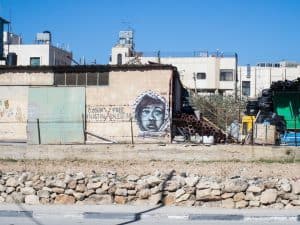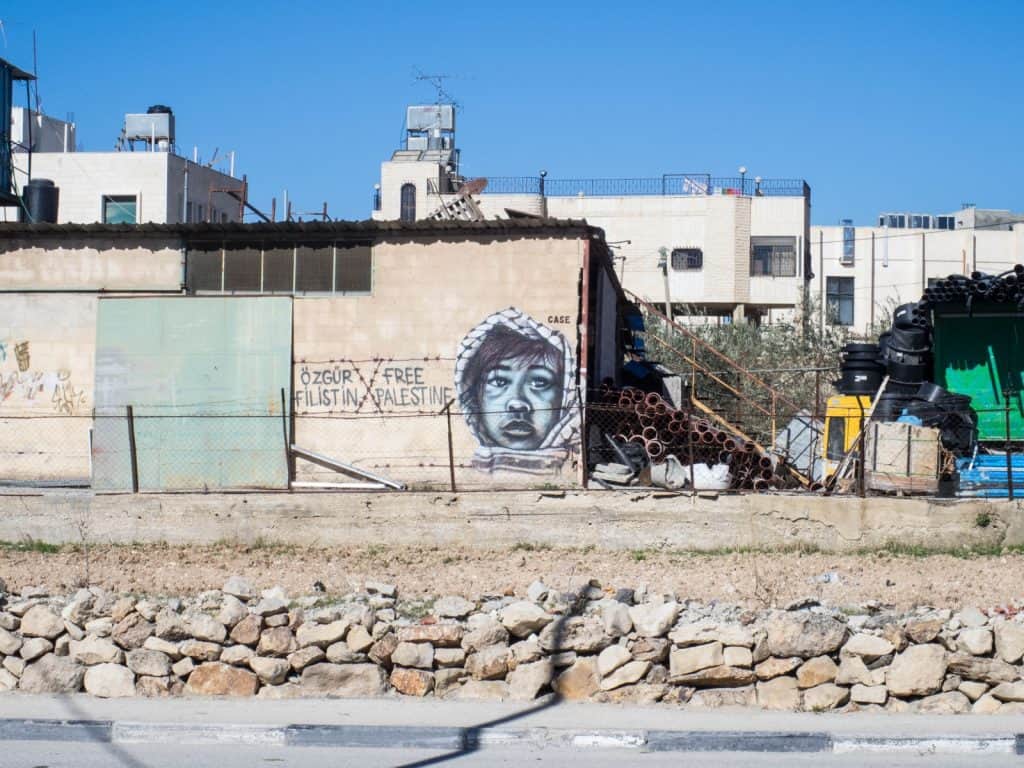There are two main reasons to visit Bethlehem these days — Christian religion and street art religion.
Every year around Christmas, between mid-December and Orthodox Christmas in early-January, pilgrims descend on Bethlehem’s old city to see the place where Jesus Christ was born. In addition to the Nativity Church in the old town, there are numerous sites across the city and its surrounding that allow worshippers to follow the footsteps of their messiah.
However, that’s not why I went to Bethlehem.
Ever since famed and reclusive British street artists Banksy first chose the city for some of his works of political commentary art in 2005, young people visiting the city get a chance to learn more about the conflict between Israel and Palestine and what it means to live in an occupied land. After my guided tour of Hebron a few days earlier, I wanted to explore for myself. And what better excuse than the scavenger hunt for graffiti?
Table of Contents
Getting to Bethlehem
I tried to research the exact location of the originally nine Banksy pieces but could only find this 2015 post by Sarah from Uneven Tenor for five pieces with some maps and Banksyworld.blogspot.com’s 2012 list of the original Westbank works, noting that already back then some had been destroyed/painted over.
Armed with the info I have found, I go over to Damascus Gate, where the “Arab buses” leave Jerusalem for various Westbank locations. The Bethlehem buses leave from the stop right by the main road/Ha Nevi’im (there is a second “Damascus Gate” bus terminal along Derech Shchlem serving other destinations such as Ramallah). I have no problems finding my bus — a sign at the stop spells the destination out in English. The ticket is 7 Shekel, actually 6.80 but the driver doesn’t bother with my change. We leave only 10 minutes after I have found my seat.
Nominally, Bethlehem is very close to Jerusalem. In fact, I had considered walking the 10km separating the two cities on the map. But the reality is that you have to do an enormous detour to bypass the wall Israel has built to shield off the Westbank. Instead of a few minutes along the highway, the bus races for 45 minutes through suburbs and along back roads to drop its passengers on Hebron Road, not far from Beit Jala and below the old town.
Girl Frisking the Soldier
My first destination is the ‘Girl Frisking the Soldier’ only a few hundred meters to the North of the bus stop on Hebron Road.
I have saved the locations mentioned in the Uneven Tenor post in my Google offline map. So I figure they should be easy to find.
At 31°42’57.8″N+35°12’05.7″E I find only a small shop that is locked at 11 in the morning. I teenage boy comes running and plugs a set of keys from a small hole next to the shop.
“Sorry, I was at school,” he apologizes.
Not for that.
I ask whether this was his shop. He grins and nods.
We go inside and there she is: The girl is frisking the soldier under a plexiglass cover, postcards and t-shirts to her left, magnets and olive wood pendants to her right.
“It’s free to look at, but you have to buy something,” the boy explains.
I am slightly irritated. To me, street art should be free, and Banksy certainly didn’t charge anyone to put his art here. So why is the boy a) blocking access and b) expecting to get paid?
Anyway, I agree and get to take a few photos. They aren’t good because the walls of the shop and the glass make it impossible to get a good angle.
After some searching, I find a postcard I want to send my sister. I pull out the NIS5 (about €1.25), which as I have learned in my few weeks in Israel is the standard rate for a postcard.
“It’s 10 Shekel.”
I look at the boy in disbelief. “No, it should be 5.” I extend my hand to give him the NIS5.
“No, it’s 10.”
I put down the card and motion to the boy that he can have the 5 as a donation. He shakes his head and says “It’s 10.”
I leave the shop, now very irritated, with a: “You know you got this piece of art for free. You shouldn’t rip people off over it!”
The Armored Dove
Next up is the “Armored Dove.” I follow Hebron Road from the Girl to the next right, Manger Street. There, on the wall of the Palestinian Heritage Center (31°43’02.1″N+35°12’08.8″E), is the big white dove in her bullet-proof vest, easily visible from a distance.
Street Art Along the Separation Wall
I turn back towards Hebron Road to find the “Armored Angel” and other works that are supposedly right on the wall (Banksyworld isn’t very clear as to which works still exist).
Where Manger and Hebron meet, a guard tower has been hit with paint bombs in red, green, black, and white — the colors of the Palestinian flag. The massive wall that runs left and right from the tower is covered in posters and graffiti.
A series of texts has children from Bethlehem describe what they wish for in their lives. They are dreaming of the freedom to go where they want to go or to study what they want to study and to sleep without the fear of soldiers bursting into their homes.
There is a smaller copy of the all-black girl with the balloons. At least it looks smaller than what I had seen in the photos. But maybe the wall just got bigger.
I also admire numerous pieces by local artists, most of them are depicting overcoming that wall.
The Banksy Shop on 31°43’13.0″N+35°12’14.8″E looks very professional — big with pretty t-shirts, postcards, and other Banksy souvenirs plus local fare like olive wood products. But there is no information to be had on where to find Banksy art around town. And no sign of the “Armored Angel,” either.
I head back out to find the two remaining pieces on my list: The “Protester Throwing Flowers” and the “Angel Scattering Hearts” are located about 3 km away in another part of town.

The Protester Throwing Flowers & Angel Scattering Hearts
I like walking, so I walk. But I could just as well have taken the bus all along Manger Street, bypassing the Old Town, getting off at the Ararat Hotel.
According to Uneven Tenor, the Angel should be at 31°42’16.9″N+35°12’52.5″E. But I look for a while, ask at the Ararat and in two shops — nobody has any clue what I am talking about. Apparently, as opposed to Hebron Road, nobody here is cashing in on street art tourism.
Eventually, I give up on the Angel and follow Beit Sahour west until 31°42’15.1″N 35°13’41.9″E. There is a gas station with car wash there. I cannot see the Protester. A smiling man in his forties approaches me. “The picture?” His face is glowing. I nod.
He takes me around to the side of the car wash. The painting is much bigger than expected, covering two floors. The flowers the protester is holding are a colorful as ever.
I ask the man whether he was the owner of the service station. He nods. I ask whether Banksy asked him before he painted the graffiti. He nods and again that proudly glowing smile covers his face. He insists on taking photos of me in front of the artwork. They are rubbish because it’s in the shade and the angle doesn’t work. But the man is happy and waves me goodbye.
I go a bit further along the road for a better view, and when I walk back past the station, I notice that there are no souvenirs. Just pride in having been chosen for a unique bit of art.
Satisfied, I turn back towards the old town, climb to the Church of Nativity, wander the narrow streets, and stroll back down to my bus back to Jerusalem.
Practical Info & Links
-
- The “Arab buses” do not operate on a fixed schedule. They usually leave when 75% full. Bethlehem buses leave at least hourly.
- You can find the bus stop going back to Jerusalem a few meters down the road from the drop-off point in Bethlehem. Simply enter the following coordinates into Google Maps: 31°42’36.2″N+35°11’53.3″E (or ask a local…).
- Note, that on the way back to Jerusalem you might have to change buses at the checkpoint. The price stays the same (NIS6.80).
- Bring your passport/visa just in case, though I have never been checked crossing between the Westbank and Israel.
- You can also get an Egged bus from the Central Bus Station (or several stops along the road) to the checkpoint outside Bethlehem and then walk across/catch a cab into town.
- For more info on transport between Jerusalem and Bethlehem check the Go Bethlehem website (prices are not current): gobethlehem.com/category/public-transportation
- For a full fill of Banksy, consider the “Walled Off Hotel” recently opened near the Banksy Shop in 182 Caritas Street: The prices are hefty but the design is fabulous. walledoffhotel.com (not to be confused with the Banksy Guest House that isn’t affiliated with the artist but a lot more affordable)
- If you don’t want to go through the hassle of organizing your transport and finding the pieces, you can also do a tour, either by hiring a cab driver along Hebron Road or joining a tour from Jerusalem – the one by Murad Tours has gotten good reviews: muradtours.com/Pages/BanksyTour.
- Or you check on Get Your Guide for tours that guide you through all the best sights:

